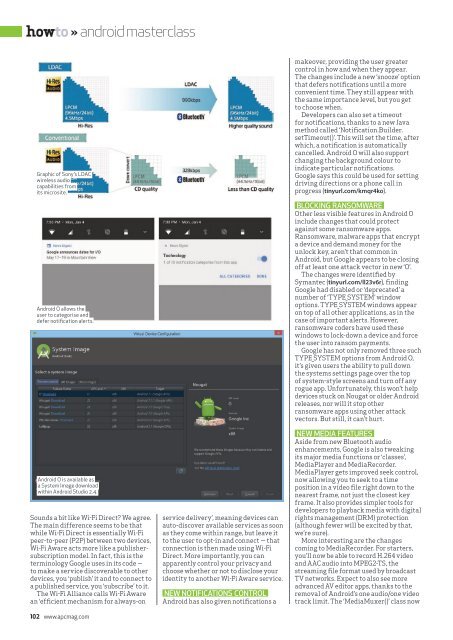You also want an ePaper? Increase the reach of your titles
YUMPU automatically turns print PDFs into web optimized ePapers that Google loves.
howto » android masterclass<br />
Graphic of Sony’s LDAC<br />
wireless audio<br />
capabilities from<br />
its microsite.<br />
Android O allows the<br />
user to categorise and<br />
defer notification alerts.<br />
Android O is available as<br />
a System Image download<br />
within Android Studio 2.4.<br />
Sounds a bit like Wi-Fi Direct? We agree.<br />
The main difference seems to be that<br />
while Wi-Fi Direct is essentially Wi-Fi<br />
peer-to-peer (P2P) between two devices,<br />
Wi-Fi Aware acts more like a publishersubscription<br />
model. In fact, this is the<br />
terminology Google uses in its code —<br />
to make a service discoverable to other<br />
devices, you ‘publish’ it and to connect to<br />
a published service, you ‘subscribe’ to it.<br />
The Wi-Fi Alliance calls Wi-Fi Aware<br />
an ‘efficient mechanism for always-on<br />
102 www.apcmag.com<br />
service delivery’, meaning devices can<br />
auto-discover available services as soon<br />
as they come within range, but leave it<br />
to the user to opt-in and connect — that<br />
connection is then made using Wi-Fi<br />
Direct. More importantly, you can<br />
apparently control your privacy and<br />
choose whether or not to disclose your<br />
identity to another Wi-Fi Aware service.<br />
NEW NOTIFICATIONS CONTROL<br />
Android has also given notifications a<br />
makeover, providing the user greater<br />
control in how and when they appear.<br />
The changes include a new ‘snooze’ option<br />
that defers notifications until a more<br />
convenient time. They still appear with<br />
the same importance level, but you get<br />
to choose when.<br />
Developers can also set a timeout<br />
for notifications, thanks to a new Java<br />
method called ‘Notification.Builder.<br />
setTimeout()’. This will set the time, after<br />
which, a notification is automatically<br />
cancelled. Android O will also support<br />
changing the background colour to<br />
indicate particular notifications.<br />
Google says this could be used for setting<br />
driving directions or a phone call in<br />
progress (tinyurl.com/kmqr4ko).<br />
BLOCKING RANSOMWARE<br />
Other less visible features in Android O<br />
include changes that could protect<br />
against some ransomware apps.<br />
Ransomware, malware apps that encrypt<br />
a device and demand money for the<br />
unlock key, aren’t that common in<br />
Android, but Google appears to be closing<br />
off at least one attack vector in new ‘O’.<br />
The changes were identified by<br />
Symantec (tinyurl.com/ll23v6r), finding<br />
Google had disabled or ‘deprecated’ a<br />
number of ‘TYPE_SYSTEM’ window<br />
options. TYPE_SYSTEM windows appear<br />
on top of all other applications, as in the<br />
case of important alerts. However,<br />
ransomware coders have used these<br />
windows to lock-down a device and force<br />
the user into ransom payments.<br />
Google has not only removed three such<br />
TYPE_SYSTEM options from Android O,<br />
it’s given users the ability to pull down<br />
the systems settings page over the top<br />
of system-style screens and turn off any<br />
rogue app. Unfortunately, this won’t help<br />
devices stuck on Nougat or older Android<br />
releases, nor will it stop other<br />
ransomware apps using other attack<br />
vectors. But still, it can’t hurt.<br />
NEW MEDIA FEATURES<br />
Aside from new Bluetooth audio<br />
enhancements, Google is also tweaking<br />
its major media functions or ‘classes’,<br />
MediaPlayer and MediaRecorder.<br />
MediaPlayer gets improved seek control,<br />
now allowing you to seek to a time<br />
position in a video file right down to the<br />
nearest frame, not just the closest key<br />
frame. It also provides simpler tools for<br />
developers to playback media with digital<br />
rights management (DRM) protection<br />
(although fewer will be excited by that,<br />
we’re sure).<br />
More interesting are the changes<br />
coming to MediaRecorder. For starters,<br />
you’ll now be able to record H.264 video<br />
and AAC audio into MPEG2-TS, the<br />
streaming file format used by broadcast<br />
TV networks. Expect to also see more<br />
advanced AV editor apps, thanks to the<br />
removal of Android’s one audio/one video<br />
track limit. The ‘MediaMuxer()’ class now


















